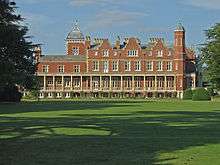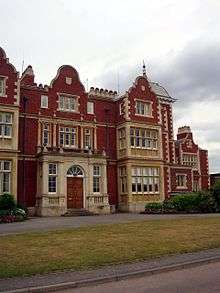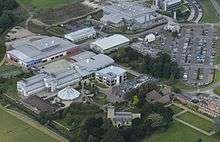Babraham Institute
The Babraham Institute is a life sciences research institution and a partner organisation of the University of Cambridge. The Babraham Institute is based on the Babraham Research Campus, partly occupying a former manor house, but also laboratory and science facility buildings on the campus, surrounded by an extensive parkland estate, just south of Cambridge, England. It is an independent and charitable organization which is involved in biomedical research, including healthy aging and molecular biology. Its latest director was Professor Michael Wakelam, who had been in post since 2007.
 | |
| Formation | 1948 |
|---|---|
| Location |
|
Director | vacant |
Key people | Wolf Reik Martin Turner (scientist) Len Stephens Phillip Thomas Hawkins |
| Affiliations | Biotechnology and Biological Sciences Research Council (BBSRC) UK Research and Innovation (UKRI) |
Staff | ~350 |
| Website | www |
Formerly called | Institute of Animal Physiology (IAP) Institute of Animal Physiology and Genetics Research (IAPGR) |



History
The institute is located on the historic Babraham Hall Estate (now called the Babraham Research Campus), situated six miles south-east of Cambridge University, near the Gog Magog Hills. It is close to where the ancient Roman Via Devana crossed the prehistoric Icknield Way. The estate includes Babraham Hall, designed in the Jacobean style by Philip Hardwick, which was built between 1832 and 1837. The hall was purchased by the Agricultural Research Council (ARC) in 1948 at the suggestion of Prof Ivan De Burgh Daly,[1] together with 182 hectares of farm and woodland to become the Institute of Animal Physiology, Babraham.[2][3]
In 1986, The Institute of Animal Physiology was joined with two Scottish institutes based at Roslin, The Animal Breeding Research Organisation (ABRO) and the Poultry Research Centre, to form The Institute of Animal Physiology and Genetics Research (IAPGR) funded by the Agricultural and Food Research Council (AFRC). In 1993, Roslin and Babraham formed two separate institutes, at which time the Babraham Institute assumed its current name. in 1994, The AFRC was disbanded and The Biotechnology and Biological Sciences Research Council (BBSRC) was formed. All work with direct relevance to agriculture ceased in 1998.
Research at the Babraham Institute
The aim of the research conducted at The Babraham Institute is to study the molecular mechanisms that underlie normal cellular processes and functions, and to understand how these systems are affected by age. The Institute's work also covers how faults or abnormalities in these systems may contribute to disease. The Institute has the status of a postgraduate department within the University of Cambridge and trains PhD students who are registered with the University's Faculty of Biology. The research laboratories of the Institute are structured around three strategic programmes:
- Signalling (headed by Len Stephens): focuses on proteins that play a critical role in controlling communication between and within cells. These proteins make up the signalling pathways that organise how cells and organs develop and react to their environment.
- Lymphocyte Signalling and Development (headed by Martin Turner): investigates signal transduction pathways that regulate the survival and activation of lymphocytes.
- Epigenetics (headed by Wolf Reik): studies how epigenetic information is introduced into the genome during early development of an organism, which can in part depend on environmental or nutritional factors acting through cell signalling pathways.
Research breakthroughs made at the Babraham Institute include the discovery of liposomes by Alec Bangham,[4] the role of Inositol trisphosphate in the release of Calcium from intracellular stores by Michael Berridge,[5] the discovery that genomic imprinting was carried by DNA methylation by Wolf Reik.[6]
Many of its past and current employees were elected fellows of the Royal Society, including Drs Ivan de Burgh Daly (1943), Sir John Henry Gaddum (1945), Marthe Vogt (1952), Richard Darwin Keynes (1959), Sir Barry Cross (1975), Sir Robert Brian Heap (1989), M Azim Surani (1990), Robin Francis Irvine (1993), Jonathan Charles Howard (1995), Wolf Reik (2010), Len Stephens (2011), Phil Hawkins (2013).
Babraham Institute Enterprise Ltd (BIE),[7] the wholly owned trading subsidiary of the Babraham Institute promotes knowledge transfer and translation of the Institute’s research discoveries, actively managing and exploiting the Institute’s intellectual property, promoting and negotiating commercial research partnerships and establishing spin-out companies when appropriate.
Funding
The Institute's research programmes are primarily supported by Institute Strategic Programme Grants (ISPGs) awarded by the Biotechnology and Biological Sciences Research Council (BBSRC), part of UK Research and Innovation. Additional grant funding comes from other research councils, such as the MRC, the Wellcome Trust, the European Commission, charitable foundations and medical charities. Some industry funding supports collaborative research projects.
Directors
- 1949-1958 Ivan de Burgh Daly CBE, FRS
- 1958-1965 Sir John Henry Gaddum FRS
- 1965-1972 Richard Darwin Keynes CBE, FRS
- 1973-1989 Sir Barry Albert Cross CBE, FRS
- 1989-1993 Sir Robert Brian Heap CBE, FRS
- 1994-2005 Richard Dyer OBE
- 2005-2007 John Bicknell (acting director)
- 2007–2020 Michael J O Wakelam
References
- "Details 1132". Archived from the original on 5 March 2016. Retrieved 8 January 2016.
- Daly, I. D. B. (1957). "A.R.C. Institute of Animal Physiology, Babraham, Cambridge". Proceedings of the Royal Society B: Biological Sciences. 146 (923): 194–205. Bibcode:1957RSPSB.146..194D. doi:10.1098/rspb.1957.0004.
- Donald William Butcher (1954) A Short History of Babraham Hall and the Babraham Estate. ASIN: B000WRZKK6
- Bangham, AD; Standish, MM; Watkins, JC (1965). "Diffusion of univalent ions across the lamellae of swollen phospholipids". J Mol Biol. 13: 238–252. doi:10.1016/s0022-2836(65)80093-6. PMID 5859039.
- Berridge MJ and Irvine RF (1984) Inositol trisphosphate, a novel second messenger in cellular signal transduction. Nature 312, 315 - 321
- Reik, W; Collick, A; Norris, ML; Barton, SC; Surani, MA (1987). "Genomic imprinting determines methylation of parental alleles in transgenic mice". Nature. 328 (6127): 248–251. Bibcode:1987Natur.328..248R. doi:10.1038/328248a0.
- "Babraham Institute Enterprise Ltd - Babraham Research Campus, Babraham, Cambridge, United Kingdom". Retrieved 31 August 2011.
